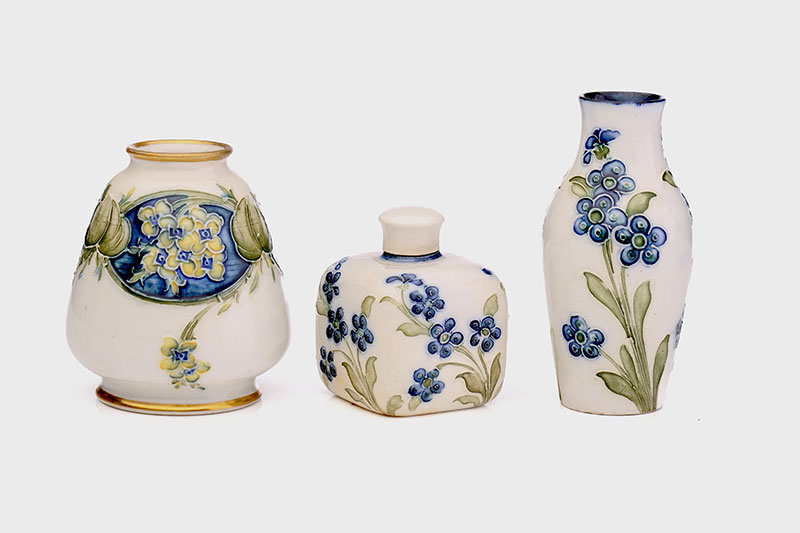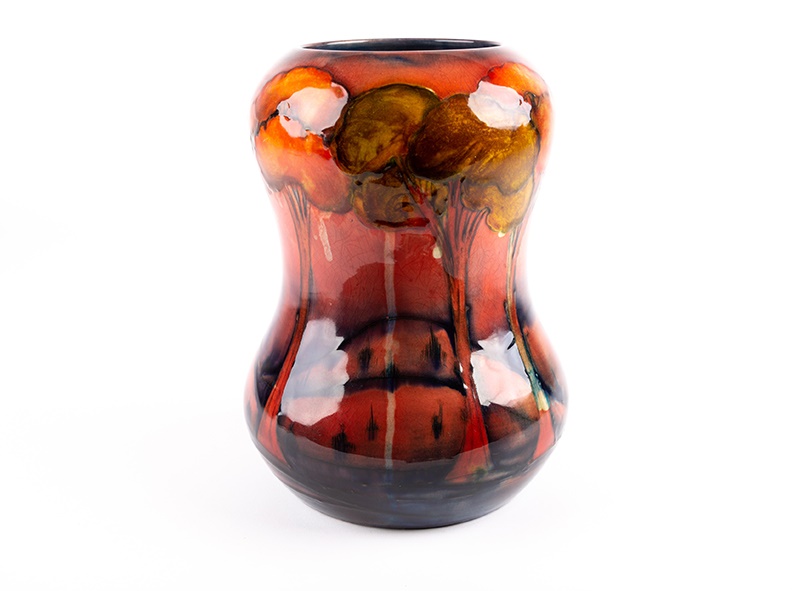How to Value Moorcroft Pottery
Expert tips and insights for appraising and determining the worth of Moorcroft pottery pieces
25/04/2023
Moorcroft pottery remains hugely popular amongst collectors. The artistic quality continues to stand the test of time providing a solid investment. However, with the price point varying so widely, we explore how to accurately value a piece of Moorcroft.
Moorcroft, or W. Moorcroft Ltd, is a British ceramic company. Founded by William Moorcroft (1872 – 1945), he was first employed at James Macintyre & Co. in 1897 when he was just 24. He went on to win a gold medal at the St Louis International Exhibition in 1904 for his Florian ware, which features a distinctive decorative method of tubelining to draw a design onto a pot like icing on a cake, with colour applied between the lines.
 A rare William Moorcroft silver overlaid 'Pomegranate' pattern three piece tea set
A rare William Moorcroft silver overlaid 'Pomegranate' pattern three piece tea set
Sold at Dawsons for a World Record £15,400
Read more: Moorcroft tea set sells for record breaking £15,400 >
In 1912 Moorcroft opened his own studio, supplying wares to prestigious shops including Liberty of London, Harrods, and Tiffany & Co. and in 1928 he earned himself another accolade, when he was appointed Potters to H.M the Queen. Following his passing in 1945, his son Walter Moorcroft took over as sole designer. He introduced many of the exotic flowers that are loved today. Walter retired in 1986 but the studio continues to produce wares to this day.
When valuing Moorcroft, the most import factors to consider include the date, the pattern, size, and shape, as well as the type of glaze, the colours, the quality of execution, rarity, and condition of the item(s) in question.
Some patterns had prolonged production lines which can make dating more difficult. Luckily, all the best Moorcroft pieces will have either impressed markings or a factory paper label to the base, identifying that it was made in England, the year it was made, the design year and the initials of the painter or tubeliner. Occasionally there will also be an artist’s mark. Note that if there is a silver stripe going through the WM monogram, this denotes that the piece is second quality or imperfect, these pieces were only sold at discounted prices in the factory shop.
 William Moorcroft for James MacIntyre, a miniature 'Lilac' conical vase
William Moorcroft for James MacIntyre, a miniature 'Lilac' conical vase
Early examples tend to have the highest value, with patterns from 1910 – 1930 remaining hotly sought after, namely Pomegranate (1910), Wisteria (1910), Eventide (1923), and Dawn (1926). Rare examples from the Macintyre period can be extremely valuable and have exceeded £10,000! These patterns include the Poppy (1898), Hazeldene landscapes (1902), Claremont with toadstool motif (1903), Tudor Rose (1904), and the monochromatic Flamminian wares. Items made exclusively for export or advertising are also quite desirable. Some modern pieces can also be quite valuable, especially those from the Sally Tuffin era circa 1980s, but pieces from William and Walter continue to be the most in demand. Recent ranges and smaller items regularly come onto the secondary market below £100.
 A rare and unusual William Moorcroft flambé vase
A rare and unusual William Moorcroft flambé vase
Ranges that include silver or pewter mounts often command premium price tags, and while bigger might be better, miniatures from the Macintyre era can attract prices which rival those of the full-size versions. Both William and Walter enjoyed using the flambé glaze technique, a high temperature firing process that produces very deep glossy red and purple tones with varying outcomes.
Moorcroft pieces feature rich colours, striking organic motifs and radiant glazes, the more prominent these characteristics, the more attractive they are to collectors. The Art Nouveau and Arts & Crafts styles continue to thrive, so naturally Moorcroft appeals to these tastes.
Related Articles
How to Identify Antique Pottery
Thinking of selling Moorcroft?
With access to a huge global audience of known buyers and collectors, Dawsons can secure the best prices when you sell ceramics.
Please get in touch for an auction estimate. We would love to hear from you: